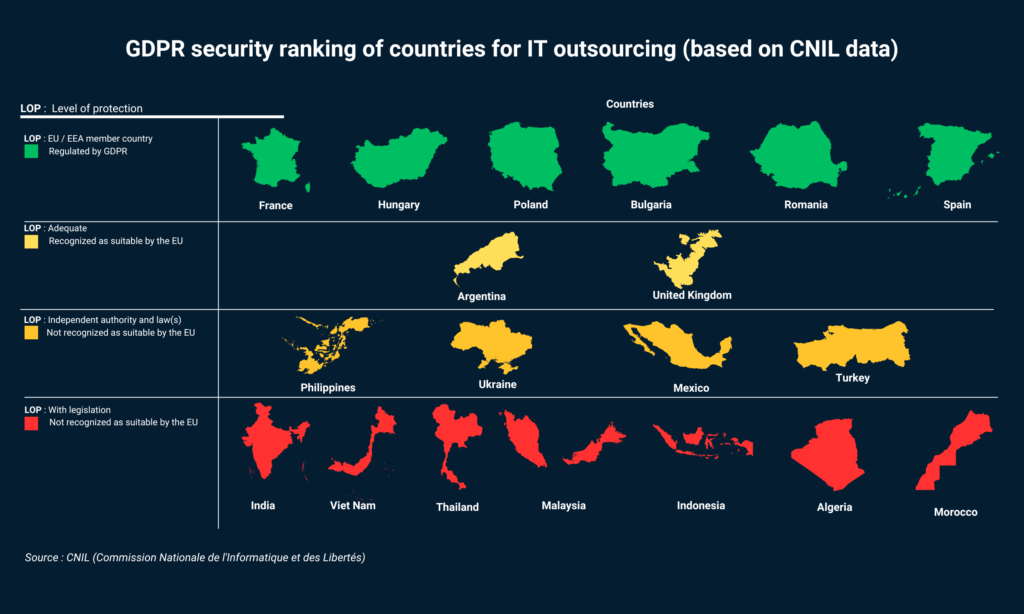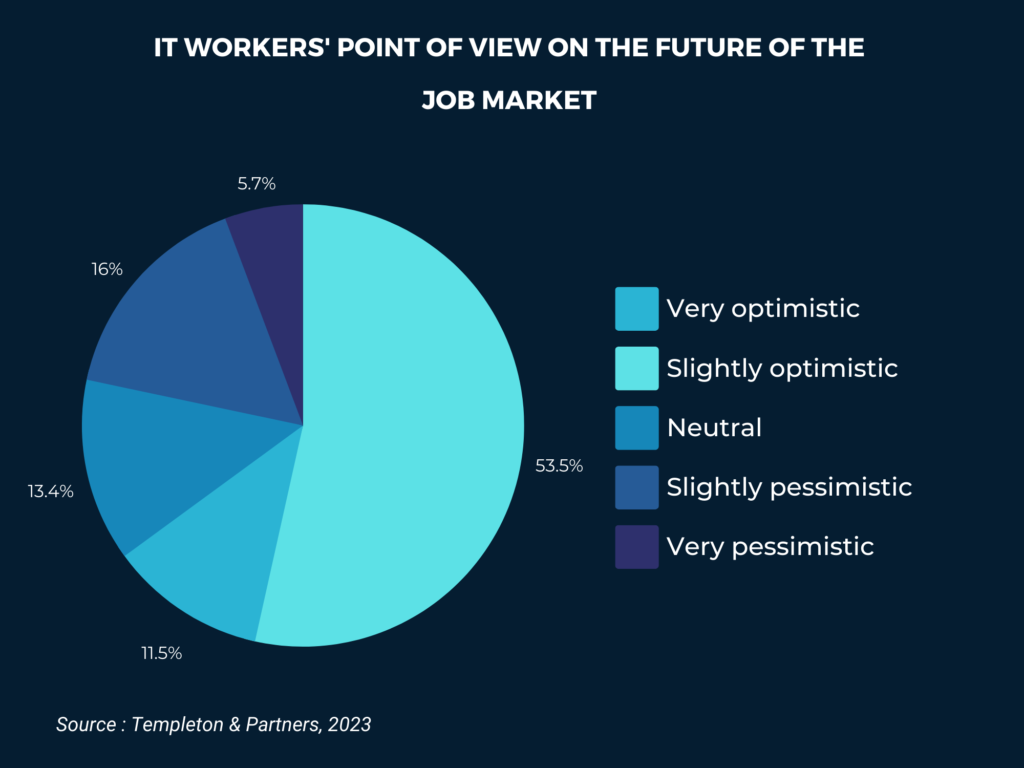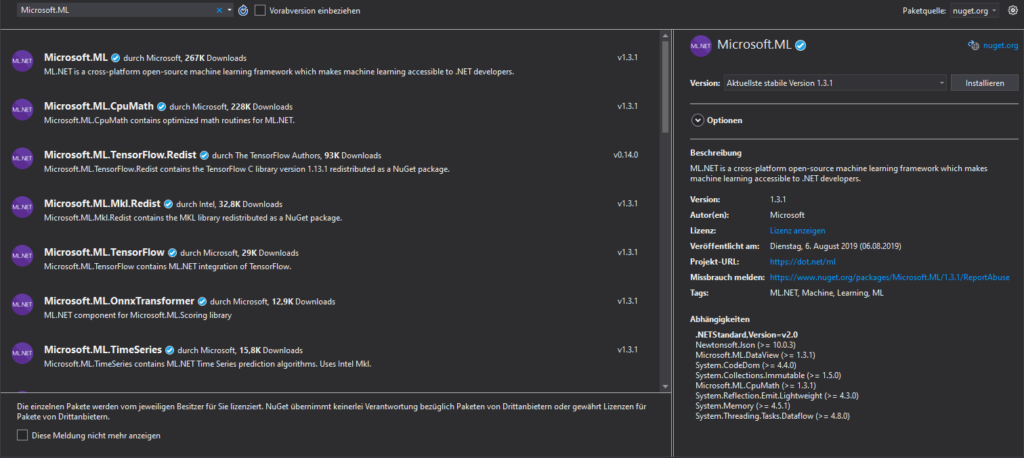THE IMPORTANCE OF GDPR IN THE IT SECTOR
How important is the GDPR (General Data Protection Regulation) in the IT field? Here’s the ranking of foreign countries heavily in demand for IT outsourcing set alongside the CNIL’s ranking of data protection in relation to EU and GDPR recommendations:

1 – What is the GDPR?
The GDPR is an EU regulation since 2018 to protect the personal data of European citizens. It defines how data must be collected, stored, processed, shared and protected by public or private organizations. Key GDPR principles include data minimization, retention limitation, integrity and confidentiality, as well as prior consent. The aim of the GDPR is to give individuals greater control over their data and to simplify regulation for international activities.
2 – Importance of the GDPR for a company with IT resources or outsourcing.
The GDPR has a direct link to the professional IT sector. As a data protection regulation, the GDPR affects the way companies manage and process the personal data of their customers, employees.
Data collection and processing: Companies must comply with GDPR rules, such as explicit consent, data minimization and security. Working with countries not recognized by the EU on this subject can lead to risks such as insecure data transfer, breach of confidentiality and difficulty in exercising individuals’ rights.
Data security: European companies must implement security measures to protect personal data against unauthorized access. Avoiding data transfers to countries not recognized by the EU and in disagreement with the GDPR is a best practice.
Individuals’ rights: the GDPR strengthens individuals’ rights over their personal data. Companies must ask their foreign business partners whose data protection is not recognized by the EU for information about the use of their data to enable them to exercise their rights, such as access, rectification, erasure and data portability.
It is therefore essential for any company with IT resources to comply with the GDPR and collaborate with countries that respect them in order to preserve the trust of customers, employees and candidates. Not only does this reduce the risk of financial penalties, it also strengthens the protection of personal data and promotes an ethical and responsible approach to data management in the IT sector.
3 – Focus on Europe
When it comes to outsourcing or recruiting IT resources, certain countries may offer financial advantages. However, it is important to favor Europe in these strategies, as data protection is an important aspect to take into account in any collaboration. Poland is an excellent alternative. It’s an EU member country with several advantages in terms of GDPR compliance. Poland is among the European countries renowned for their privacy-friendly culture and solid IT development expertise. What’s more, with competitive costs compared to other European countries, Poland offers an economic opportunity for French companies to consider.
- THE IT MARKET IN FULL GROWTH
The information and technology (IT) sector is undoubtedly a major driver of economic growth. According to a Gartner study, global IT spending is expected to reach $4.5 trillion in 2023, a 6.2% growth compared to 2022. This dynamism is largely driven by the rise of digitalization (web & app), cloud computing, cybersecurity and artificial intelligence.
At the same time, the IT sector is also a powerful creator of jobs. According to the U.S. Bureau of Labor Statistics, IT jobs are expected to grow by 11% between 2019 and 2029, a rate well above the average for all other sectors. In Europe, the European Commission projects an increase of 1.7 million IT jobs by 2025.
The IT market has been very resilient in the face of the Covid-19 crisis. As this graph shows from data obtained from Statista, the IT market has experienced stable growth from the pre-Covid period to the post-Covid period.

2. A DYNAMIC BUT DEMANDING MARKET
The fast-growing IT sector offers many opportunities for IT professionals. However, it also presents significant challenges. To remain competitive, these professionals must constantly update their skills and adapt to new technologies and work methods.
By 2021, the number of people employed in the technology industry has been estimated at more than 18 million globally. From software engineers to data scientists to UX designers to cybersecurity specialists, careers in technology offer a variety of opportunities for those with the right skills and experience.
However, the tech job market remains competitive. Salaries for technology professionals are generally higher than those in other industries and unemployment rates are relatively low, demonstrating the attractiveness of the sector.
Here’s a chart from Statista that shows the most in-demand positions for IT recruiters worldwide in 2023.

3. PERSPECTIVES FOR THE IT MARKET
La technologie, outil majeur de résilience durant les périodes d’incertitude comme celles vécues ces dernières années, devrait continuer à être un moteur de croissance dans le futur. Selon un rapport de Templeton & Partners en 2023 sur ‘L’État de l’Emploi et des Carrières des Professionnels du Marché IT‘, environ 65% des travailleurs du secteur technologique interrogés se montrent optimistes quant au marché de l’emploi en 2023 et au-delà.
Cet optimisme est toutefois tempéré par les défis inhérents à un secteur en constante évolution. Presque 22% des professionnels de la technologie interrogés se montrent insatisfaits de l’avenir du marché de l’emploi et de leurs perspectives de carrière. Cette inquiétude est principalement due au rythme rapide des changements dans le secteur, qui peuvent rendre difficile le suivi des dernières tendances et technologies.

Machine learning has become an increasingly popular field in recent years, with many organizations looking to leverage its capabilities to gain insights from their data and improve their operations. One of the key advantages of using .NET for machine learning is its compatibility with commonly used programming languages such as C# and F#. This means that developers can use their preferred programming language to create machine learning models while still taking advantage of the benefits of .NET.
In this article, we will delve into the specific benefits of using this tech, including its wide variety of libraries and frameworks, its support for low-data learning, and its ability to be integrated with a variety of platforms.

One of the major advantages of .NET for machine learning is its compatibility with commonly used programming languages such as C# and F#. This means that developers can use their preferred programming language to create machine learning models while still taking advantage of the benefits of .NET. This can make it easier for developers to understand and work with the code, as well as make it easier to hire developers with the skills needed to work on machine learning projects.
https://robowiki.net/wiki/Robocode/.NET/Create_a_.NET_robot_with_Visual_Studio
.NET also has a wide variety of libraries and frameworks available for machine learning, such as ML.NET and Accord.NET. These libraries provide advanced features such as image recognition, speech recognition, and time series prediction. Developers can use these libraries to create powerful machine learning models without having to reinvent the wheel. Additionally, these libraries are well documented and have a large user community, which can be helpful for troubleshooting and getting answers to questions.
Check our project: Sensteria
Another advantage of .NET is its support for low-data learning. Low-data learning algorithms, such as clustering and convolutional neural networks, can be used to identify hidden patterns in data and create robust machine learning models. This can be especially useful in cases where data is scarce or difficult to obtain.
This language also has the ability to be integrated with a variety of platforms, including Windows, Linux, and macOS. This allows developers to create and deploy machine learning models on the platform that best fits their needs. Additionally, this flexibility can be beneficial for organizations that use a mix of different platforms and want to ensure their machine learning models can be used on all of them.
In conclusion, .NET offers a wide range of benefits for machine learning, including its compatibility with commonly used programming languages. Its wide variety of libraries and frameworks, its support for low-data learning, and its ability to be integrated with a variety of platforms. Developers can use .NET to create powerful machine learning models and deploy them on the platform that best fits their needs. .NET is an ideal choice for developers who want to use their preferred programming language while taking advantage of the benefits of machine learning.
New Year’s resolutions for 2023
Developing applications using the Microsoft .NET framework can be a challenge, but by following the latest best practices and tips, you can significantly improve your development process. At ITSharkz, we have compiled a collection of tips and best practices provided by members of our network to help you become an expert .NET. developer.
One of the most important tips is to stay up-to-date with the latest versions of .NET. Updates often bring performance and security improvements, so it’s crucial to install them as soon as they are available. Also, by using development tools such as Visual Studio, you can easily follow the latest trends and best practices in development.
It’s also important to organize your code well. Use consistent naming conventions and comments to make your code easy to understand for yourself and other developers. Also, by using version control tools such as Git, you can easily manage different versions of your code and collaborate effectively with other developers.
By using good programming practices, such as using design patterns and SOLID. principles, you can also improve the quality of your code. This will allow you to create more robust and maintainable applications.
It’s also important to consider the performance of your application. By using profiling tools and performing load tests, you can identify areas to improve and optimize the performance of your application.
Finally, by following best practices for security, you can protect your application against common vulnerabilities. This includes using encryption to protect sensitive data and using access controls to limit access to sensitive features of the application.
By following these tips and best practices, you can become an expert .NET developer and create high-quality applications. Visit our ITSharkz website for more tips and best practices for .NET development. #dotnet #bestpractices #développementdesoftware
Python is well known to be one of the most useful programming languages. You can do almost anything with it, from web applications, through image processing, to data science and machine learning. It’s like a Swiss army knife for programmers. However, some people still claim several superstitions.
Although Python is easy to learn because of its syntax and the fact that it is a dynamic programming language, some mention that it might be too slow. At IT Sharkz we had similar doubts, but our experience since then has proven that these concerns were unfounded. So we will try to tell you the truth as objectively as possible.
What does it mean that a language is slow?
Each programming language can be described in different ways. In terms of language efficiency, two categories come to mind: speed of production and performance. In which of these categories could we say that Python is slow? Let’s check!
Production / delivery speed
In many cases, the speed of production and delivery of a language is its most important parameter. It tells us when we can potentially expect delivery of a finished application and allows us to design an appropriate release schedule. Since Python can be used in almost all stages of a project (since we can use it to create the application, test it and prepare the project environment), a single skilled developer could handle the whole production process from start to finish.
Due to the higher development speed, the use of Python could indeed result in a smaller number of developers required for a project, which would have the added benefit of reducing project costs.
But taking care of a project is not only about creating brand new applications, it also means continuous maintenance and support. The code written in Python is very clear and easy to read thanks to its syntax and the PEP8 standard.
Graph showing the average number of hours needed to solve a problem (Prechelt and Garret)
As you can see in the graph above, there is no doubt that Python performs very well compared to other languages in terms of production speed.
Performance
This parameter tells us how fast a programming language can handle a problem. At the moment, the languages that shine the most in this respect are C and C++. Indeed, it makes sense to use them in certain cases, such as creating video games, compilers, or whenever a large number of calculations and good memory control are required. But what about other cases?
Each of the above use cases requires a huge amount of computation. Nevertheless, Python continues to be the most popular language used in machine learning or image processing. Let me now explain why.
In the first paragraph I mentioned that Python is often accused of being slow, which is only partially true. I don’t want to accuse anyone, but the truth is that most of the time this argument is used by beginners.
If your project uses machine learning, more often than not, it will have to rely on some external libraries, like SciKit and TensorFlow, both of which are available for Python.
Since these libraries are written in C++, when used in Python scripts, we use C++ in the background. This makes the development process fast and makes our script as fast as those written in C++. The same goes for image preprocessing (OpenCV library). You can clearly see that in this case too, Python serves as a wrapper for C++.
Web development
Python is great for building web applications. And when you start your web development journey, it’s not exactly easy to choose your first web framework and when it comes to Python, the selection on offer is quite large: we have Django, Flask, TurboGears and many more.
Django is by far the most popular Python web framework, and it powers some of the biggest apps and websites you know, including Spotify, and YouTube (though it was originally built in PHP), and BitBucket.
If Python was as bad as some people claim, these projects probably wouldn’t have been as successful as they were. Also, assuming that the performance of a web application depends solely on the code and language chosen is a huge mistake.
The performance of an application depends on a number of factors, and properly written and optimized code is only one of them. Overall performance is also limited by bottlenecks. What are bottlenecks? Well, the name is pretty self-explanatory. Fluid speed is limited by the bottlenecks it encounters. What differentiates a good developer from a bad developer is that the good ones know when to optimize the code. Nick Humrich, Python guru and former Amazon engineer, explains this sentiment very well:
If your optimizations aren’t touching the bottleneck, you’re wasting your time and not fixing the real issue. You won’t get any serious improvements until you optimize the bottleneck (…) Optimizing code before you measure and determine where the bottleneck is, is known as “premature optimization”. – Nick Humrich
If you still think that optimization is the most important thing to increase application speed, maybe someone like Donald Knuth, the author of The Art of Computer Programming, will convince you:
We should forget about small efficiencies, say about 97% of the time: premature optimization is the root of all evil. Yet we should not pass up our opportunities in that critical 3%. – Donald Knuth
Spending countless hours improving code just to make it a few nanoseconds faster makes no sense, especially from the customer’s point of view.
Conclusion
Is Python slow? While native Python code may seem to have a high execution time, especially when considering benchmarks, when it comes to commercial use, the speed it offers is more than satisfactory for most applications.
What makes Python so powerful? Mainly its high level development speed and variety of uses. Furthermore, it would be hard to find a programming language that makes application development easier and more enjoyable than Python.
